Menus
- Daily test for 15 days of the stainless German Swiss Army knife
- Flat Twin ShiftCam 1,254 cm3, 136 hp, 143 Nm, 249 kg full made, from 24,200 euros
- Discovery
- In the saddle
- In the city
- Motorway and expressways
- Departmental
- All Terrain
- Braking
- Comfort / Duo
- Consumption and autonomy
- Revisions
- The 40-year BMW GS 1250 video test
- Conclusion
Daily test for 15 days of the stainless German Swiss Army knife
Flat Twin ShiftCam 1,254 cm3, 136 hp, 143 Nm, 249 kg full made, from 24,200 euros
It’s always hard to write about a new GS. If I had to draw a parallel with the automobile, it would be a bit like writing a paper on the Porsche 911. Admittedly, they have absolutely nothing in common except their country of origin, but these two machines are both the irremovable icons of their category since … always! Yet the birth of the GS is due to an incredible combination of circumstances. Before the GS, almost all trails were powered by (large) single cylinders. So what gave the Bavarian the idea to develop an all-terrain chassis around his legendary flat-twin? ?
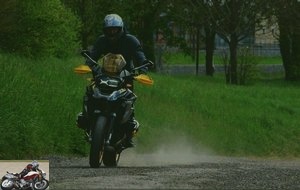 A road trail to take along the paths
A road trail to take along the paths
I’ll give you the short version: the Japanese wave in the 1970s put all European motorcycle manufacturers at risk and the two-wheeler branch of BMW was no exception. In 77, it already smelled of fir for BMW with sales in free fall. And in 79, the group’s management summoned the head of the motorcycle division, Karl Heinz Gerlinger, to tell him in substance: "either you make a profit or we stop everything". It was therefore necessary to come out of new models and quickly. By “luck”, the GS already existed as a prototype (technically bitzas: a large handlebar and longer travel suspensions grafted onto a standard machine). Other prototypes were ordered from the Italian Laverda in 78 (specific frame, extended swingarm …) to verify the viability of the concept on an industrial scale as well as its efficiency. Apparently the machines were pretty well born, as they won gold in 79 and 80 at the International Six Days Trial – the ancestor of the ISDE. But Hans Muth, the head of design at BMW (father of the R 90 S and later of the Suzuki Katana) will water down the “war machine” side of the prototypes on the commercial version. His idea was to produce the two-wheeled equivalent of a Range Rover, hence the trade name of G / S (for Gelande / Strass or TT / road).
Well, the very first big road trail in the history of motorcycles still took a little while to find a place in the sun. If the very first GS – the R80 – won everything it could in competition (including four victories in the “real” Dakar), this did not translate into an interplanetary commercial success. For that, it was necessary to wait until the end of 87 and the release of the R 100 GS. Since then, BMW has been working to refine its formula from generation to generation (we are in the sixth) to, again and again, continue to make it the benchmark of the segment of large road trails that it invented..
Today, the GS is the flagship of the brand and its bestseller. The German produced close to 1.3 million copies and it is still today the No. 1 registrations in France and the best-selling large displacement in the world. So much for the historical side, I hope it was not too off-putting. You can now undo your seat belts, wait for the plane to come to a complete stop before collecting your luggage. I now invite you to go to the 2021 transit room for your next flight.
Discovery
If you haven’t read the R 1250 GS review when it was released last year, I invite you to click here to read David’s ultra-comprehensive review. If this is already the case (or if you are fighting the quilts), let’s get straight to the heart of the matter with the changes made to the 2021 vintage. We will then focus on the specifics of this “40th anniversary” version..
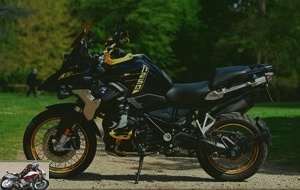 The R 1250 GS, the trail reference and a 40-year anniversary
The R 1250 GS, the trail reference and a 40-year anniversary
So for 2021, the flat twin 1240 cm3 ShiftCam of the GS goes to Euro 5 standards. At its launch, BMW had announced its new flat with variable valve timing as being Euro 4 AND Euro 5 ready. And on paper the output is identical with still 136 hp and 143 Nm. We will see what this gives to use below. By the way, the ABS and ASC duo is now coupled to an original inertial unit (previously optional) which means that the brakes and traction control now take into account the angle taken by the machine before acting. Another novelty is the appearance of an Eco driving mode to help you reach the announced 4.75 l / 100 km of normalized consumption. Or to save the planet if you have the green fiber. Above all, the GS also includes in its original equipment hill start aid and (finally) two charging sockets: a USB to the right of the dashboard and a mini 12 V just under the driver’s seat. The Hill Start Control (HSC – hill start aid) also incorporates the original equipment.
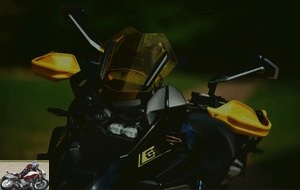 a look that we find on the lower displacements
a look that we find on the lower displacements
Now let’s move on to the specifics of this 40th anniversary model. Already, there is the specific decoration, with yellow and gold everywhere in a very strong nod to the second GS, the R 100 of 1988: tank, hand guard, specific cylinder head cover in cut aluminum mass, anodized handlebars, screen, sails of the spoke rims (tubeless please). All wrapped in an irreproachable finish.
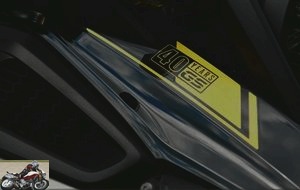 40 years anniversary model
40 years anniversary model
Please note, this is not a full option model, our test machine was equipped with a few additional trinkets including an Akrapovic Sport exhaust, a lightweight battery and the pack of aluminum parts cut in the mass Billet Pack Shadow II (mirrors, levers, brake selector and pedal, footrests, brake and clutch jars). And above all – I will come back to this in the saddle section – the low passenger kit composed of separate driver-passenger seats, both heated and adjustable in height.
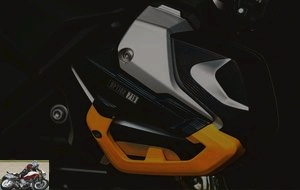 Two-cylinder flat boxer engine, with accessories Option 719
Two-cylinder flat boxer engine, with accessories Option 719
But let’s come back to our sheep, this 40 Jahre livery has the original right to all the usually optional packs (Connected, Dynamic, Enduro and Touring). Suddenly there are lots of extra things like GPS pre-equipment, automatic and adaptive headlights in bends or a Shifter Pro, but we especially have access to the most popular options such as keyless start and ESA electronic suspensions. latest generation capable of real-time hydraulic and spring preload adjustment. We also have access to 7 driving modes, including two Pro modes (Dynamic and Enduro) which are customizable to your liking. Forget Enduro, optimized for nipple tires, but Dynamic became my default mode very quickly. My preference is for the most aggressive throttle response, traction control that allows wheelies and ABS on the intermediate setting given the irascible side of the spring weather in Île-de-France. Finally, note that the shortcut on the handlebars for the driving modes only allows you to select 4 predefined modes. To change the modes, you have to go rummaging through the submenus.
Last remark concerning the technological endowment, directional lighting is very … circumstantial. Great at night in the departmental area, it is very discreet the rest of the time. Or its effects are not obvious. It’s probably perfect if you’re a night watchman who lives on the Larzac plateau, but otherwise I don’t really see the point. Instead, I would have much preferred backlit switches to know where to put my fingers. Considering the amount of buttons, it wouldn’t have been luxury.
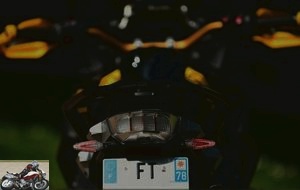 LED rear light
LED rear light
In the saddle
Do not dream, the GS is a big trail and with a saddle perched between 850 and 870 mm high, do not expect to put both feet flat when stationary below 1.75 m. But that does not mean that the little ones are deprived of GS either. With the low saddle option combined with the ESA suspensions – which also integrate a low position by releasing the spring preload at the front and rear – the perch goes down to 800 mm. From above, I have the toe joints completely on the ground from the top of my 170 cm (and 74 cm at the crotch if you want to offer me custom-made pants).
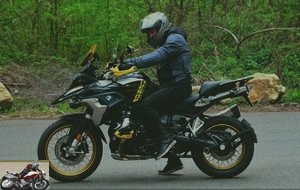 On tiptoe for small sizes
On tiptoe for small sizes
After that, you always have to deal with the 249 kg of the beast in working order. Even after 15 days spent on the handlebars, maneuvers at a standstill are always a great moment of solitude, especially if the asphalt is not perfectly dry. I ended up taking the reflex to systematically pre-sway before each stop while checking if the asphalt is neither bulging nor smashed where I was going to dismount. For the rest, we are swimming in happiness. The driving position is natural, the soft controls, the ultra-comfortable saddle and the triangle saddle handlebar footrest is clearly designed to eat the terminal per pack of 1000.
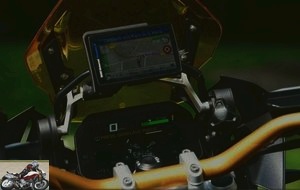 The GPS overhanging the 6 "5 TFT panel on the dashboard
The GPS overhanging the 6 "5 TFT panel on the dashboard
With the transponder in the pocket, it only takes a long press to unlock the steering and a short press to wake up the huge 6.5 inch TFT screen. A word of advice to buyers, infusing the user’s manual to understand how the on-board computer works is almost imperative. If you choose (like me) the rule of thumb, you will have a hard time understanding the logic of German interface designers. Well, after five days, I was at home, but when you reach the same level of mastery after 15 minutes on a KTM, it leaves you wondering. Here it is said. And then, after a while, it feels natural to you and you naturally navigate in it. It is ultimately a fold to take.
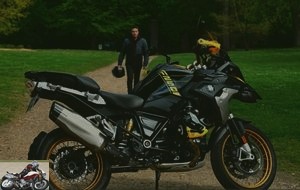 Daily BMW R 1250 GS test
Daily BMW R 1250 GS test
In the city
After pressing the starter button, the twin immediately gives way. Strangely enough, the exhaust valves open for the first few seconds and then gradually close. It’s very pleasing to the ear, but a bit too noisy when you go to test the night lighting at 2:00 am. Small detail, the red zone is scalable. When cold, it starts at 5500 rpm just to preserve the mechanics until the oil and water reach their optimum temperature and gradually rise to 9000 rpm. The idea is not new. Unless I’m mistaken, BMW introduced a similar device 22 years ago on the M5 E39. But it’s always good to say that an electronic guardrail has preserved the mechanics when buying second-hand.
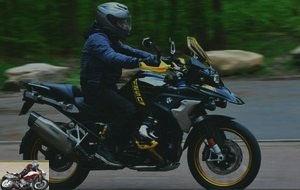 143 Nm at 6,250 rpm
143 Nm at 6,250 rpm
Another clever detail that you do not necessarily notice on a lightning test, the Hill Start Control does not work in uphill. When stationary, it is enough to apply the brake lever or the pedal a little firmly for a fraction of a second to bring the GS to a stop indefinitely. And the HSC is automatically released when starting up or when the brakes are applied again..
I continue with the good news? As soon as you roll, the weight flies away. This is the whole paradox of this GS. Intimidating when stationary, it turns into a real bike as soon as you exceed 2 km / h. This is the magic of the flat twin and its ultra low center of gravity. Better, the turning radius is ridiculously small and the U-turns are done in a pocket square. The flexibility of the twin is also an ally of choice. The flat resumes without flinching from 2000 revs and even accepts to evolve on the idle speed, even on the sixth report (50 km / h at 2000 rev / min). Bets on the angle require two grams of effort on the handlebars and the front axle, super reassuring, seems permanently riveted to the ground.
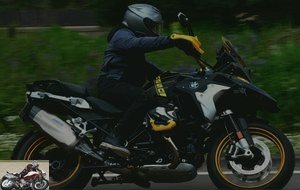 the weight is quickly forgotten despite the 249 kilos
the weight is quickly forgotten despite the 249 kilos
It is hardly that in betweeniles that the GS loses a little of its splendor. The large handlebars are still not far from a meter wide … Admittedly, it goes over most mirrors, but this is less and less true since everyone buys SUVs. And still think of the cylinders flat at the bottom so as not to tear off a bumper…
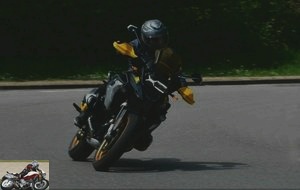 Easy and reassuring in all conditions
Easy and reassuring in all conditions
A quick word about the Pro shifter, not at all convincing in this environment. He gives you random jerks and he even occasionally refused to change gears without using the clutch. No problem, the clutch is so soft to operate that you do very well using your right hand.
Motorway and expressways
At 130 km / h, the tachometer needle is right at half-speed or 4500 rpm and the flat purrs like a big cat while giving you – good – vibrations. And even if we are below the optimum operating zone of the engine (maximum torque is available at 6,250 rpm), overshoots are dispatched in the blink of an eye. The screen is adjustable, but manually via a dial to the right of the dashboard.
 136 hp at 7,750 rpm
136 hp at 7,750 rpm
After a week of use, I got into the habit of leaving it in the low position and only raising it on long journeys on the highway. The level of protection is very correct (a high screen is available as an option) if we disregard a few aerodynamic noises and the saddle is as comfortable and welcoming for the driver as the passenger. Add in the equation a tank with XXL dimensions and a cylinder in front of each of your guiboles and you get an overall protection close to a GT. And then finally there is the Paralever (the gimbal, therefore). Its double articulation eliminates all the torque effects typical of this type of transmission while avoiding tedious chain lubrication sessions.
Departmental
The main characteristic of a large departmental trail is that the large suspension travel allows you to ride in royal comfort whatever the state of the road. In return, you have to curb your ardor a little if you want to spread. Not here. The GS never has the rocking horse side of most big trails. This is partly due to the electronic suspensions, which wonderfully curb load transfers, but above all to the Telelever front axle which decouples the damping and guiding functions. On hard braking, the GS gives the impression of becoming embedded in the ground rather than tilting forward. The result is a serenity of behavior that is truly bluffing even on a departmental which has not received a visit from the DDE for 20 years. The double Kiss Cool effect of the Telelever is that it provides an incredible amount of information about the grip available.
 Easy to attack
Easy to attack
If you want to play, either let the microchips handle everything for you, or switch to Dynamic Pro mode which dramatically sharpens throttle response and firmer ESA suspensions. There you find yourself riding a big sporty roadster a little leggy (or a huge supermotard). And as long as you keep the tachometer above 5,500 rpm, the thrust is explosive. And the flat does not run out of steam once past its maximum power regime (7,750 revs) and offers a welcome extension up to almost 8,500 revs. The Shifter Pro, not breathtaking in town, is here a valuable ally and the brakes are perfectly up to the situation, although we would have liked a little more feeling on the lever.
As long as the road is smooth, don’t expect to circle around a big, hairy roadster either. But you will sweat much less to ride so fast because even on the attack, the GS remains easy and reassuring. On the other hand, if the conditions deteriorate, consider taking some reading (I recommend the entire War and Peace) while your friends join you. After that, don’t ask me how a GS behaves without the ESA. Since its introduction on the first R 1200 GS in 2004, I have never tried a machine from the brand’s press park that has not been fitted with it….
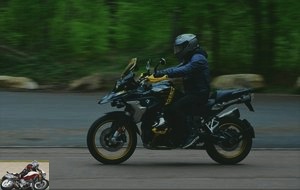 A comfortable trail
A comfortable trail
All Terrain
The all-terrain? Yes but not too much. In any case with the original tires with a much too road profile. In this configuration, it is recommended to restrict yourself to rolling paths. If you ride with nipple tires, on the other hand, the GS will literally take you anywhere. Combined with the Enduro Pro mode (specially designed for this pneumatic ride) which manages the ABS and traction control, you can do crazy things as long as you have the arms and the level. Do not hesitate to take a look on Youtube to have the demonstration and in particular the course at the Enduro Park on the Den, the video is edifying. Personally, if the GS were my daily coach, I would have a cold sweat at the thought of wallowing in the mud with a 249 kg machine that costs over 20k €. Afterwards, it is you who see with your banker.
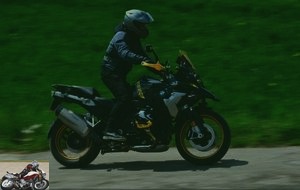 Handy both in town and on the roads
Handy both in town and on the roads
Braking
The rear brake is a precious ally in town. Efficient, powerful, but not too much, it sits the bike effortlessly and with good sensations under the pedal. Up front, the 305mm dual disc is both powerful, dosable and has an excellent feeling as long as it is not used to its full potential. Note that this GS 40 Jahre benefits from the dynamic braking DBC (Dynamic Brake Control) delivered with the Dynamic pack which acts as an anti-dribble system by regulating the throttle valves and the pressure on the rear brake during downshifts..
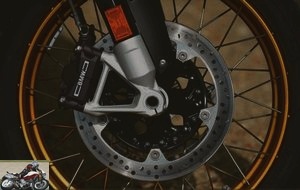 Double floating disc brake, Ш 305 mm, four piston brake calipers
Double floating disc brake, Ш 305 mm, four piston brake calipers
Comfort / Duo
A GS is comfortable, in fact at the same level as a 1250 RT, for the pilot as well as the passenger and more than an RT as soon as you go out in the small roads.
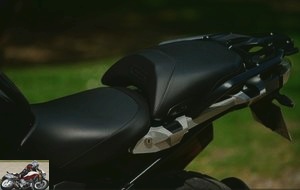 Saddle adjustable to 850/870 mm
Saddle adjustable to 850/870 mm
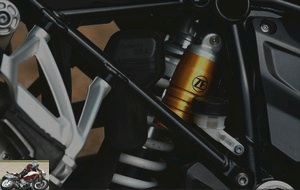 ESA shock absorber
ESA shock absorber
Consumption and autonomy
The 4.75 l / 100 km are certainly achievable, but with a rifle tendonitis in the right wrist or on the highway at cruise control. In real life, a small 5 / 5.5 liter is closer to the real thing. The 20-liter tank gives it a theoretical range of around 370 km. The flat is remarkably sober in almost all conditions (except in town) and the driving pace has, in the end, little influence on average consumption..
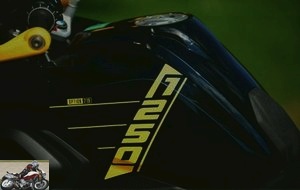 20 liter tank
20 liter tank
Revisions
The R 1250 GS requires a service every 10,000 km, with the first only an oil change (+ oil filter) and checking and cleaning of the air filter (allow 160 euros every 10,000 and 300 euros every 20,000 per service in medium).
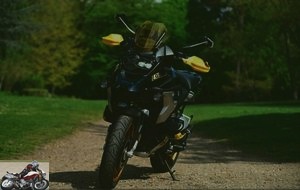 1,254 cm3 (102.5 x 76 mm)
1,254 cm3 (102.5 x 76 mm)
The 40-year BMW GS 1250 video test
Conclusion
If you are able to deal with the saddle height and the jig when stationary, this machine is close to perfection. On the other hand, there is an Adventure variant even higher and a heavier chouia with its huge 30-liter tank and a metal exoskeleton for ex-basketball players and tightrope walkers. The TLDR of this review is that the GS doesn’t excel at anything, but does everything (very, very) well. If we were to note everything in the Auto Plus, it would be entitled to a nice 8.5 / 10 everywhere: comfort, autonomy, ease of driving, efficiency, power, torque, load capacity…
In the BMW range, an R 1250 RT or a K 1600 GT are better travelers. And if you love the trails, but are allergic to mud, an S 1000 XR may be more suitable. And if we talk about the competition, the GS no longer dominates its category head and shoulders. For all terrain Baja style, the KTM 1290 Super Adventure is more suitable. Both lighter and more powerful, it is also better placed on the price side with equivalent equipment. And at Ducati, the overpowered Multistrada V4S (170 hp) will probably be more efficient in sporty driving. And both have tech gadgets (adaptive cruise control, blind spot detector) that are lacking – for the moment – in the GS.
But in terms of sheer versatility, the Swiss-German Army Knife is still THE benchmark of its genre. Its homogeneity is impossible to fault and it fulfills the role of globetrotter as well as that of sidewalk scavenger. So much for the goal. On the subjective side, he also has a lot to say. Even people with chronic motorcycle allergies know what a GS is. It is part of the motorcycle pantheon just like a Honda Goldwing, a Ducati Monster or a Harley Electra Glide.
But to put your butt on this rolling myth, you will have to go to the cash register (€ 24,200 for this 40-year edition and more than € 27,000 for our test model) and agree to comply with BMW’s confusing policy of personalization. On paper, you can have an à la carte machine, but access to certain options is sometimes linked to the purchase of a complete pack. Impossible for example to order a GS just with heated grips and a low seat. The first are linked to the Comfort pack (900 €), the second to the Dynamic pack (1565 €). I’ll let you tear your hair out with the configurator, I’ll take mine as a full option, just like everyone else…
Strong points
- Twin “perfect”
- Breathtaking chassis / electronic suspension combo
- Royal comfort
- Ultimate versatility
- The myth ?
Weak points
- The salty price and the “mandatory” options
- Weight when stationary
- The Pro shifter not at the level of the competition
- The ultra-complete on-board computer, but not at all user-friendly
The technical sheet of the BMW R 1250 GS 40 Years
Test conditions
- Itinerary: town + small varied roads + highways
- Weather: very variable, dry rain, hot-cold 6 ° to 18 °), we had everything, thank you spring !
- Problems encountered: I do not know who is the brainless who had this GS before me, but in the handlebar shortcuts he replaced Enduro mode with Enduro Pro; optimized for studded tires (which I didn’t know at the time). As much to say to you that I made oil on my first kilometers of road…
Test equipment
- Shoei GT Air II Helmet
- Alpinestar jacket
- Uglybros motorcycle jeans
- Helston Side summer gloves
- Vanucci shoes
Related articles
-
Daily test over 3,500 kilometers, from Spain to Italy by small roads Flat Twin of 1,254 cm3, euro5, 136 hp and 143 Nm, 279 kg, 22,490 euros … and the…
-
The big gap Test over 2,000 kilometers from France to Germany via Luxembourg R1250! This is the 2019 novelty, the 2019 novelties should we say since the…
-
Suzuki Bandit 1250 S ABS motorcycle test
If you’re looking for a tiger in an engine, roar a Bandit 1250 The presentations are really no longer to do but, with this version equipped with a fork…
-
Cargo Flat twin, 1254 cm3, 136 hp, 143 Nm, 243 kg all full facts, 15,350 euros. Old tradition as the RS model at BMW, until the previous R 1200 RS. The…
-
BMW GS 1250 motorcycle test daily
Flat Twin ShiftCam of 1,254 cm3, 136 hp and 143 Nm, 249 kg full made, from 17,599 euros Daily test for 15 days Already more than 800,000 big GS sold in…
-
The smart boxer Flat Twin ShiftCam of 1,254 cm3, 136 hp and 143 Nm, 249 kg full made, from 17,400 euros Only one year after the renewal of its F750GS and…
-
Yamaha MT-10 SP & Tourer Edition test
Two more road and sporty evolutions of the MT 10 4-cylinder Crossplane, 160 hp, € 14,999 and € 15,999 In 2009, Yamaha presented the Yamaha R1 Crossplane:…
-
Harley-Davidson Pan-America 1250 test
The wild equid V-Twin Revolution Max, 1,252 cm3, 150 hp, 128 Nm, from 15,990 euros On the vast plains of America in the early 1900s, the asphalt roads of…
-
Suzuki Bandit 1250 N GSF motorcycle test
The Suzuki Bandit 1250 is the evolution of the Bandit 1200, the big historic roadster unveiled in 1995, having hit sales not only for its puncture-proof…
-
Upgrading Unchanged since 2012, the Yamaha 450 WRF has this time been completely revisited. Derived from the excellent YZF cross model, this new Yamaha…